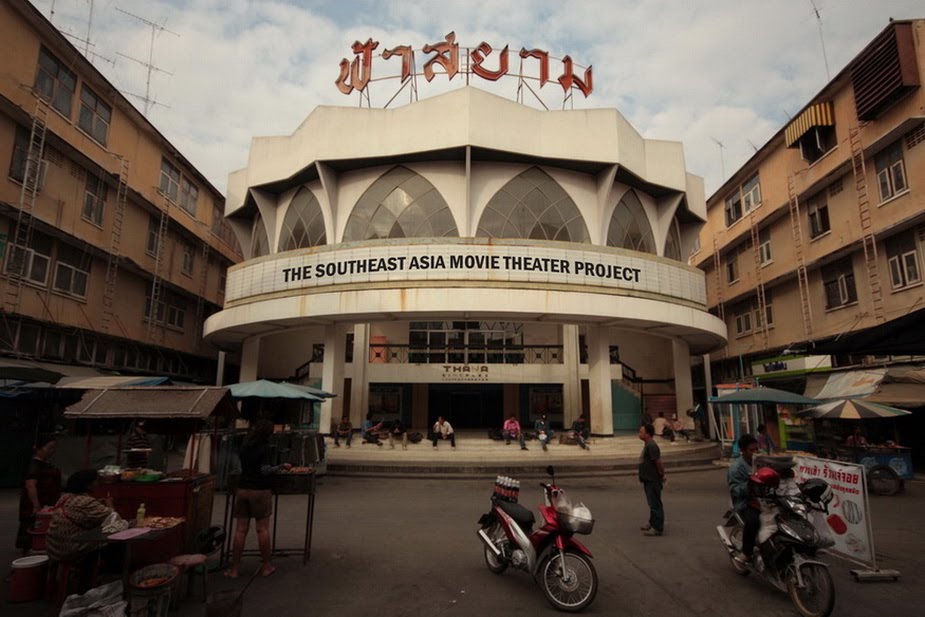 It was instantly apparent that the San Pya had been a victim of degeneration over the years. There was no need to venture inside to figure that out. The dank air gushing from the entrance smelled like a jungle cave minus the guano. Whatever personage or wildlife had taken refuge therein would be better left to the imagination, I figured. Seats filled with movie-watching leopards, maybe?
It was instantly apparent that the San Pya had been a victim of degeneration over the years. There was no need to venture inside to figure that out. The dank air gushing from the entrance smelled like a jungle cave minus the guano. Whatever personage or wildlife had taken refuge therein would be better left to the imagination, I figured. Seats filled with movie-watching leopards, maybe?Surrounding vendors and passersby eyed me curiously as I shot away at the theatrical flophouse towering above. Opposite the theater, at an unusually-fashionable-for-Yangon ice cream parlor, mid-day revelers sat staring as if I were committing murder with an ice pick in front of their very eyes. Others traded coy smiles, casting side-long glances in my direction as if asking, "what's so interesting about that dump?"
 "San Pya" overlaid in the tile along the theater's side. San Pya means "standard." On the facade, traces of a vertical sign protrude outwards.
"San Pya" overlaid in the tile along the theater's side. San Pya means "standard." On the facade, traces of a vertical sign protrude outwards.And so, after forty-five minutes of casual scrutiny it became clear that the San Pya Cinema is a city unto itself. Perimeter retail space, a common feature among Myanmar's movie theaters, was accompanied by residential dwellings, a not-so-common feature. Several compartments along the ground-level perimeter were being rented out as such. Four, five, six people to a room.
The woman in the above photo greeted me while I meandered around the theater's exterior. She was visibly anxious about speaking to me, but equally intent on doing so, it seemed. A proper Burmese English accent belied a decent education from decades before, though the laws of English grammar had faded with time. Her mission, I soon learned, was to point out that she resided in the theater. For six years, she said, she'd been a San Pya Cinema lodger. Upon hearing this, I was seized by a momentary jolt of opportunism as I considered asking her permission to enter. My pressing queries, all forty-five stewing minutes worth of them, would be definitively answered once the San Pya's inner realities were made known. But her shifty eyes and nervous disposition made me think twice. In place of a tour I settled for a photo of her in the threshold of her gate, leaving the inner realities to their privacy.

 The man sitting on the far right of the photos sells cigarettes, cheroots and betel nut. The sign on the left announces the movie show times.
The man sitting on the far right of the photos sells cigarettes, cheroots and betel nut. The sign on the left announces the movie show times. Later interviews confirmed my suspicions about the San Pya, however. One respondent linked its lowly status to its proximity to several major bus routes which connect the surrounding countryside to downtown Yangon. Once within the anonymous environment of the city center, said my informant, the theater makes an ideal place for waywards to "relax" in relative privacy. But it wasn't always this way, of course.
In years past the San Pya Cinema qualified as a premier downtown movie theater. A few senior Yangonians I spoke to recalled the days when sell-out crowds came regularly to enjoy the state of the art comforts it provided. Those days may be gone, but it's not difficult to picture the old theater in dazzling condition. One key artifact that would add a much needed glimmer to the San Pya if it were still in place is the old vertical sign. Remnants of it can be seen protruding from the facade, but its absence has critically dulled the international style architecture. What a difference a sign makes.
 As Yangon slowly embarks along the road to change, lets hope that the San Pya gets restored to its past glory.
As Yangon slowly embarks along the road to change, lets hope that the San Pya gets restored to its past glory.











































